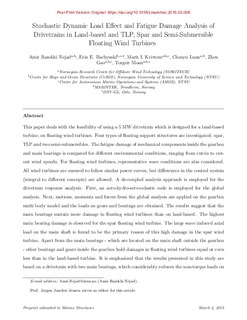| dc.contributor.author | Rasekhi Nejad, Amir | |
| dc.contributor.author | Bachynski, Erin Elizabeth | |
| dc.contributor.author | Kvittem, Marit Irene | |
| dc.contributor.author | Luan, Chenyu | |
| dc.contributor.author | Gao, Zhen | |
| dc.contributor.author | Moan, Torgeir | |
| dc.date.accessioned | 2017-12-27T08:39:43Z | |
| dc.date.available | 2017-12-27T08:39:43Z | |
| dc.date.created | 2015-05-04T13:57:43Z | |
| dc.date.issued | 2015-07 | |
| dc.identifier.citation | Marine Structures. 2015, 42 137-153. | nb_NO |
| dc.identifier.issn | 0951-8339 | |
| dc.identifier.uri | http://hdl.handle.net/11250/2473754 | |
| dc.description.abstract | This paper deals with the feasibility of using a 5 MW drivetrain which is designed for a land-based turbine, on floating wind turbines. Four types of floating support structures are investigated: spar, TLP and two semi-submersibles. The fatigue damage of mechanical components inside the gearbox and main bearings is compared for different environmental conditions, ranging from cut-in to cut-out wind speeds. For floating wind turbines, representative wave conditions are also considered. All wind turbines are ensured to follow similar power curves, but differences in the control system (integral to different concepts) are allowed. A de-coupled analysis approach is employed for the drivetrain response analysis. First, an aero-hydro-servo-elastic code is employed for the global analysis. Next, motions, moments and forces from the global analysis are applied on the gearbox multi body model and the loads on gears and bearings are obtained. The results suggest that the main bearings sustain more damage in floating wind turbines than on land-based. The highest main bearing damage is observed for the spar floating wind turbine. The large wave induced axial load on the main shaft is found to be the primary reason of this high damage in the spar wind turbine. Apart from the main bearings - which are located on the main shaft outside the gearbox - other bearings and gears inside the gearbox hold damages in floating wind turbines equal or even less than in the land-based turbine. It is emphasized that the results presented in this study are based on a drivetrain with two main bearings, which considerably reduces the non-torque loads on the gearbox. | nb_NO |
| dc.language.iso | eng | nb_NO |
| dc.rights | Navngivelse-Ikkekommersiell-DelPåSammeVilkår 4.0 Internasjonal | * |
| dc.rights.uri | http://creativecommons.org/licenses/by-nc-sa/4.0/deed.no | * |
| dc.subject | Floating wind turbine | nb_NO |
| dc.subject | Drivetrain | nb_NO |
| dc.subject | Wind turbine gearbox | nb_NO |
| dc.subject | Wind turbine fatigue | nb_NO |
| dc.title | Stochastic dynamic load effect and fatigue damage analysis of drivetrains in land-based and TLP, spar and semi-submersible floating wind turbines | nb_NO |
| dc.type | Journal article | nb_NO |
| dc.type | Peer reviewed | nb_NO |
| dc.description.version | acceptedVersion | nb_NO |
| dc.rights.holder | The authors | nb_NO |
| dc.source.pagenumber | 137-153 | nb_NO |
| dc.source.volume | 42 | nb_NO |
| dc.source.journal | Marine Structures | nb_NO |
| dc.identifier.doi | 10.1016/j.marstruc.2015.03.006 | |
| dc.identifier.cristin | 1240351 | |
| dc.relation.project | Norges forskningsråd: 193823 | nb_NO |
| dc.relation.project | Norges forskningsråd: 223254 | nb_NO |
| cristin.unitcode | 7566,8,0,0 | |
| cristin.unitname | Ocean Engineering | |
| cristin.ispublished | true | |
| cristin.fulltext | postprint | |
| cristin.qualitycode | 2 | |

